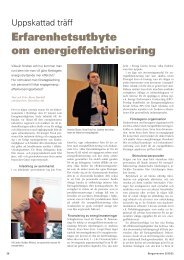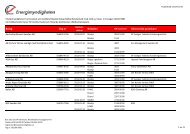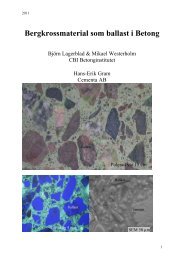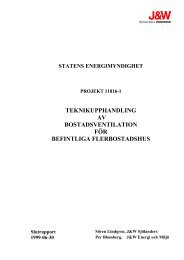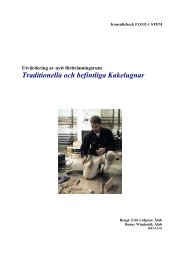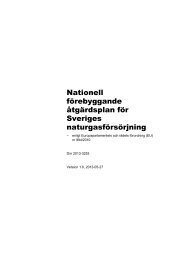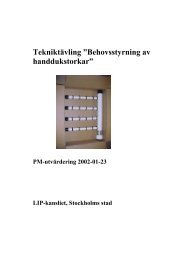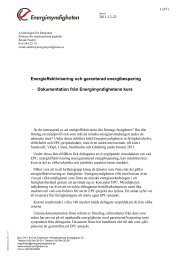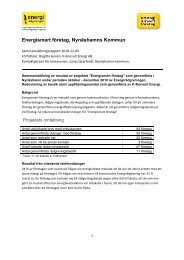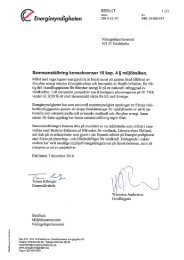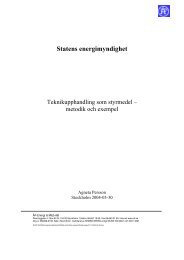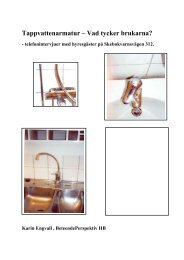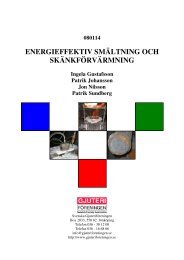ATAC i system - Energimyndigheten
ATAC i system - Energimyndigheten
ATAC i system - Energimyndigheten
Create successful ePaper yourself
Turn your PDF publications into a flip-book with our unique Google optimized e-Paper software.
7. Evaluation and reporting.<br />
2<br />
So far, activities have only been carried out in the three first steps (due to that until recently<br />
there was no PhD candidate available). Step 2 is completed and the current activities focus on<br />
establishment of a strategy for the experiments.<br />
Results<br />
Process evaluation<br />
The process evaluation focussed on integration of the air separation unit (ASU) with the<br />
power process, and design of a flue gas treatment scheme. Thus, a process scheme is proposed<br />
and evaluated. Also, emission data were obtained together with estimates of the investment<br />
cost of the plant. Commercial state-of-the-art data from an existing 2x865 MW power plant<br />
(Lippendorf) and commercial design data of large-scale ASU and auxiliary components<br />
(compressors, separators etc.) were used as bases for the study.<br />
The ASU is integrated with the power cycle and optimized with respect to purity of the<br />
product gas (95% O2). Since no air pre-heater is needed in the O2/CO2 plant, there is extra<br />
heat available, compared with the reference plant. Also, heat is recovered from the flue gas<br />
condenser introduced. Different alternatives for the use of these heat flows are proposed, such<br />
as heating of the Nitrogen flow in the ASU. Intercooling of the compressors, cooling to<br />
condensate the flue gas and to bring the carbon dioxide in a liquid state are provided by the<br />
ordinary cooling tower. Significant energy savings were obtained from the process<br />
integration.<br />
The flue gas treatment passage consists of units for cleaning from particulates, water<br />
condensation, dehydration, compression of the flue gas and separation of non-condensable<br />
gases. To meet the requirements for transport of the flue gas with respect to hydrate formation<br />
and corrosion, the gas is dehydrated after the traditional flue gas condensers. The process<br />
suggested permits deposition of the sulfur dioxide solved in the liquid carbon dioxide, i.e.<br />
there is no need for a conventional desulfurization unit. After dehydration the flue gas is<br />
compressed to 58 bars and cooled to 15°C, i.e. the carbon dioxide and sulfur dioxide are<br />
transformed to liquid state, and the non-condensable gases are separated. Before<br />
transportation, the pressure of the carbon dioxide is increased to a suitable level with a pump.<br />
The proposed plant, forms a near zero emission plant as 99.5% of the CO2 is separated from<br />
the flue gas, and very low levels of sulfur emissions, particulates and low emissions of nitrous<br />
gases are achieved.<br />
Since the O2/CO2 plant needs no desulfurization unit the total investment cost (including the<br />
ASU) is similar to that for a conventional. The extra energy consumption for the CO2<br />
separation and liquefaction reduces the output from the plant to 700 MW, compared to 865<br />
MW of the reference plant.<br />
Based on the results of the process evaluation, an abstract has been submitted to the GHGT6<br />
conference (Int. Conf. on Greenhouse Control Technologies).<br />
Test rig with instrumentation<br />
Detailed dimensioning of the test rig and design of measurement plan is carried out at present<br />
and is also the main focus of the activities in the near future. Since there is now a PhD



